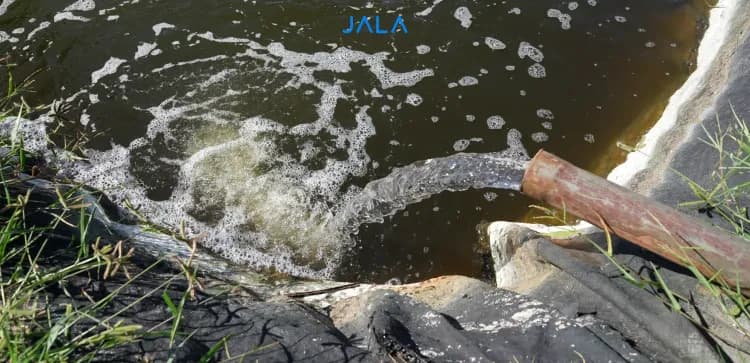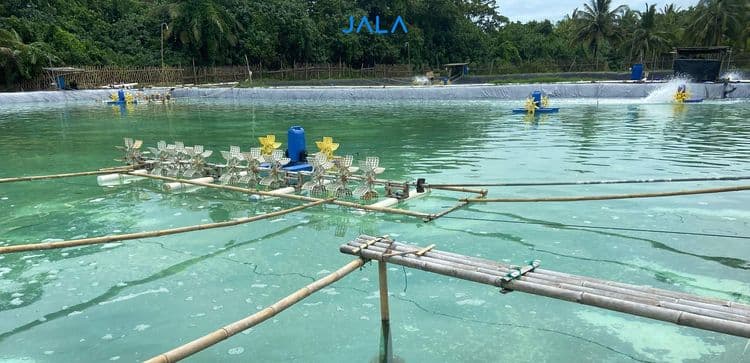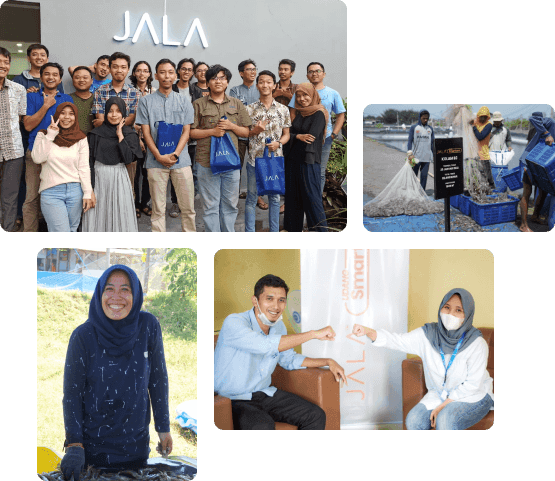
Harvesting is the final stage of shrimp farming. In its execution, they must pay close attention to the procedure of harvesting shrimp in order to maintain shrimp quality.
There are several technical preparations that must be made prior to harvesting. The shipment, tools, and, of course, manpower must all be readied. All of these aspects must be considered to ensure an expeditious harvesting process.
What are the Steps to Harvest Shrimp?
At least six stages must be performed during the shrimp harvesting process. To avoid degrading the quality of the harvested shrimp, all of these steps must be carried out properly.
1. Removing Water
For farmers planning to do a total harvest, the first step to harvest shrimp is removing water. Water should be removed to increase the effectiveness of harvest.
Water removal can be done gradually to anticipate stress in shrimp. This step can be skipped for farmers doing partial harvest.
2. Catching Shrimp
Catching shrimp is the first stage of harvesting. Harvesters will use a net to collect shrimp from the pond.
The main thing to remember is the technique. To avoid damaging the shrimp, do not overfill the net. Furthermore, this step is commonly carried out when the pond water temperature is not too high.
3. Washing and Sorting Shrimp
Shrimp is washed after being collected from the pond to remove mud, sand, and moss adhered to their bodies. Washing is also another way to maintain shrimp quality.
Shrimp that has been washed are then sorted by quality. To expedite the selling process, shrimp that are suitable for sale are sorted from those that are not.
The sorting step will produce three kinds of shrimp: fresh, BS (Below Standard), and KM (Kulit Muda). The shrimp is drained after sorting to minimize the amount of water in their bodies.
4. Sampling
The next step in the shrimp harvesting process is sampling. The harvester will determine the size of the shrimp to be harvested.
Sampling is done one pond at a time. For example, if there are ten ponds, sampling will be done ten times. This process is crucial to determine the price of the harvested shrimp.
5. Weighing Shrimp
Weighing is the next step in the shrimp harvesting process. An adjusted scale (tare weight) is used to weigh the shrimp in the basket. Later, the shrimps are weighed per several kilograms, such as 20 kg, 25 kg, or 30kg. Doing so eases the process of recording the shrimp tonnage obtained.
6. Packing Shrimp
The final step in the shrimp harvesting process is packing. Shrimp is placed in ice-filled fibers to prevent decomposition and maintain its quality until it reaches the warehouse or processing factory.
A layer-stack model is used to organize the shrimp and ice inside the fiber (ice-shrimps-ice-shrimps).
Afterwards, the packed shrimp is supplied with ice water in various volumes based on their placement in the truck or pickup car. After packing, the shrimp is shipped to the warehouse or processing factory.
Steps for Successful Shrimp Harvest Planning
A successful harvest requires careful planning. In the planning, there are several steps that need to be the focus for farmers.
Identify the Alignment between the Target and Reality
Before harvest, it is necessary for farmers to recheck the predetermined target at the beginning of the cultivation cycle. Next, compare it with the cultivation record data during the cycle, including the shrimp growth rate and its average weight during sampling.
In this case, a complete data record is essential. Without a complete record, farmers cannot make the right decision for their harvest.
Maintain Water Quality
The next planning step is to minimize excessive water quality fluctuations. This measure is done to anticipate the amount of molting shrimp. Shrimp that are molting during harvest will reduce its economic value.
In addition, it is also important to keep measuring the dissolved oxygen (DO) level regularly at night. If the DO level declines and approaches the minimum level, which is 4 ppm, farmers need to do partial harvest.
Ensure the Readiness of Harvesting Tools
Harvesting tools, such as net, basket, and scale, are the main components of harvesting. Before harvest time, make sure that all those tools are in good condition and function optimally. This needs to be done to support the harvesting process.
Monitor Shrimp Prices Trend
Fluctuating shrimp prices becomes a challenge for farmers. This can be anticipated by monitoring shrimp prices trends in the farm area. By identifying price information, farmers can estimate the profitability of every kilogram of their shrimp.
Conduct Harvest Simulation
Conducting simulation may give early projection regarding the total price of harvest. Besides pre-harvest, farmers can conduct simulation even before the cultivation cycle actually starts and during cultivation.
How Long Does It Take Before Shrimp Can Be Harvested?
Many shrimp farmers target harvesting after the shrimp reaches the age of 100-120 days or when they reach a size of 20-40 g per individual.
The shrimp size is achieved through a well-designed feeding program. However, if the expected size is not achieved, a reevaluation of water quality, weather conditions, or shrimp health is necessary.
Furthermore, farmers must also take into account market conditions and consumer demand to determine the appropriate harvest timing.
2 Types of Shrimp Harvest
There are two methods for harvesting shrimp that farmers usually do, namely partial harvest and total harvest.
1. Partial Harvest
Partial harvest is taking only a part of the shrimp population from the pond and leaving the rest to be cultivated until a certain age. Partial harvest aims to reduce stocking density in ponds, lowering the risk of disease transmission and maintain the environmental carrying capacity.
Partial harvest can also increase productivity and profits because the size of the shrimp obtained at the end of cultivation will be larger.
2. Total Harvest
Total harvest is the activity of taking all the shrimp in the pond when their size has reached the target or sales criteria. Farmers may also consider total harvest if shrimp prices in the market show signs of significant drop.
However, farmers are advised against panic harvesting. Instead, find the most stable price and continue cultivating to reach the best price.
Tips for a Successful Shrimp Harvest that You Should Know
A good harvesting process results in good shrimp quality. After understanding the steps of shrimp harvesting, here are some tips you need to know when conducting the harvest, covering preparation before the harvest to the actual harvesting.
1. Make Sure Shrimp is Not in the Molting Stage
Molting shrimp will reduce the price as it is usually categorized under KM. Conduct sampling to ensure that less than 5% of shrimp is molting and less than 10% of them have soft shells.
Molting can be avoided during harvest, for example, by applying lime and 400-500 kg/ha of white cement. Additionally, the use of dolomite can also harden the shrimp's shell. Molting can also be prevented by increasing water pH and preventing shrimp from becoming stressed during harvesting.
2. Maintain Feeding Before Harvest
Feeding should still be done at least a day before harvesting. Stopping feeding before harvest can affect shrimp quality, as they will continue searching for food from the pond bottom. This can cause the hepatopancreas to enlarge and give a black color to the shrimp's head, reducing the quality of the shrimp due to its less attractive appearance.
3. Harvest at Low Temperature
The best time to harvest is at night during the new or full moon. Besides avoiding molting, temperatures are relatively lower at night. High temperatures can lead to high shrimp metabolism and potential stress, even causing them to die faster.
4. Harvest as Fast as Possible
Speed is a key factor of vannamei shrimp harvesting in ponds. To maintain shrimp quality, harvesting should be done as quickly as possible. Ideally, harvesting should be completed within a 3-hour duration.
The use of harvest gates can be an alternative and more efficient method, saving time and energy.
5. Reduce Water
Reducing water levels is a crucial step in total harvesting. Water should be reduced according to the total shrimp biomass, as excessive water during harvesting can prolong the duration and cause stress to the shrimp.
Harvest Planning Simulation in JALA App
As in the aforementioned discussion, simulation is one of the important harvest planning steps. The good news is, JALA is #HeretoHelp with the Simulation Feature in JALA App. The Simulation Feature in JALA App provides the profitability projection from the harvested shrimp and allows you to determine the partial harvest plans.
Not only does it facilitate harvest planning, you can leverage the Simulation Feature to view the projection of feed and shrimp biomass in charts. Make sure to fill the data completely to get accurate results.
The following is the guide on how to use the Simulation Feature in JALA App:
- Select the Simulation Feature in the Homepage.
- Select “Create Simulation”.
- Fill the simulation data completely, especially those related with harvest. The Simulation Feature facilitates farmers with the partial harvest time planning as well.
- Once all data has been filled, select “Show”.
- In the harvest section, you can view the biomass and size projection and the total price. To get the total price, select the desired location in the Price Table.
- Select “Save” if you want to save the simulation results.
 An example of simulation data filling
An example of simulation data filling
There are three sections in the simulation results: Harvest, Feed, and Biomass. In the Harvest section, you can identify the overview of harvest total price for a particular biomass and the size that has been filled in at the beginning. In the example below, a partial harvest at DoC 100 has the potential to reach a total price of IDR 77,214,500. While the total harvest at DoC 120 is listed at IDR 115,824,000.

In the Feed and Biomass charts example above, there is a sharp decline at DoC 100, followed by another decline at DoC 120. The decline at DoC 100 indicates a partial harvest and the total live biomass declines drastically based on the shrimp biomass taken. Meanwhile, the second decline at DoC 120 indicates a total harvest or the end of cultivation cycle.
Conclusion
 Harvest intends to collect cultivated shrimps in accordance with the economic value target. From catching the shrimps to packing, the quality of shrimp must be maintained so that its economic value remains high. Partial or total harvest can be chosen by carefully considering the pond’s carrying capacity and current shrimp prices.
Harvest intends to collect cultivated shrimps in accordance with the economic value target. From catching the shrimps to packing, the quality of shrimp must be maintained so that its economic value remains high. Partial or total harvest can be chosen by carefully considering the pond’s carrying capacity and current shrimp prices.
When harvesting vannamei shrimp, make sure the shrimp is not in the molting stage. Continue feeding before harvest and harvest quickly when the temperature is low to avoid stress in shrimp.
For a more optimal yield, plan your harvest carefully, namely by conducting simulation. You can do it conveniently with the Simulation Feature in JALA App, which will provide you with insight into the potential income from your harvest.
Register yourself at app.jala.tech and download the mobile version on the Google Play Store or App Store to reap the benefits of the Simulation Feature. Let’s do better in cultivation and harvest planning!





